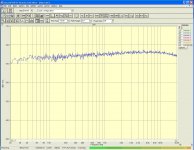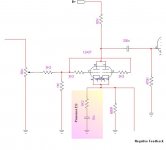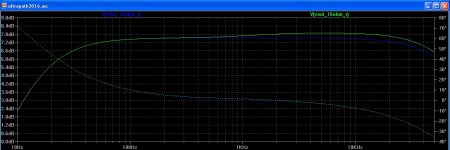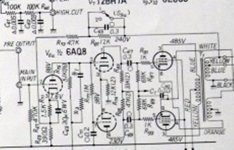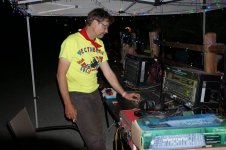What about adding a slight "presence" boost RC network fixed in the amplifier.
According to vintage guitar schematics I have added a "presence filer" to my amplifier for music that alters the response of the amp by boosting of 0.5dB the high frequency range (2~10 KHz). The result is a brighter sound with greater clarity and "presence".
It is implemented as a low pass filter inside the global negative feedback loop and is simply an RC network at the cathode of the triode (15nF + 8.2KOhm with pole at 1.3KHz).
At the beginning I thought to use a switch to exclude it if necessary, but at the end the sound was so amazing (overall with voices) that I leave it fixed forever.
I know to break in this way the most important rule of an hi-fi machine (i.e. having a flat response), so let me know what you think about this unusual choice.
According to vintage guitar schematics I have added a "presence filer" to my amplifier for music that alters the response of the amp by boosting of 0.5dB the high frequency range (2~10 KHz). The result is a brighter sound with greater clarity and "presence".
It is implemented as a low pass filter inside the global negative feedback loop and is simply an RC network at the cathode of the triode (15nF + 8.2KOhm with pole at 1.3KHz).
At the beginning I thought to use a switch to exclude it if necessary, but at the end the sound was so amazing (overall with voices) that I leave it fixed forever.
I know to break in this way the most important rule of an hi-fi machine (i.e. having a flat response), so let me know what you think about this unusual choice.
Attachments
My experience with tone controls is that I can not hear 0,5 dB difference and I am quite sure I am not the only one.
I can detect the difference in tone when treble (Baxandall type) is adjusted to some 2...3 dB.
How did you ended up to 0,5 dB ? Is 1 dB too presence ?
Hello, the +0.5dB means boost 5-6% the upper mid-range and this is both visible in the simulation and White Noise measurement even if it is very light.
There are two reasons why I choose this:
1) I didn't want to break too much the hi-fi rule to have a "flat response"
2) I tried by "ear" several combination of RC components for several hours and that was the best trade-off between airy-realistic sound and have a metallic, too much bright sound. As soon I experienced synthetic, grainy, or dry character I stopped.
As I told before this is a fixed RC filter: if I put a rotary switch, of course I would have enlarged the range by few decibels as you said.
I found a lot of commercial amplifier with presence switch but never one with a fixed RC one.
A half dB step can frequently be a huge step in a recording studio situation, quite audible. The basic circuit you show is very common in vintage broadcast/recording gear as transformer droop compensation, with some manufacturers giving different values depending on the input impedance taps to be used. In amps lacking overall NFB you also see series R between plate and grid with a bypass C.
I know to break in this way the most important rule of an hi-fi machine (i.e. having a flat response), so let me know what you think about this unusual choice.
I find it oddly refreshing for any audiophile to openly admit that tonal coloration is a principal goal. This uncomfortable truth is usually just an unspoken undercurrent, always plausibly deniable, carefully hidden under layers of bushwa and propaganda extolling the sonic virtues of overpriced components and mystical circuit design features. Yay for diyAudio!
Coloration is a principal goal of cargo-cult audiophiles who heard sound of some naturally sounding systems that have some drawbacks. They assume drawbacks to be the main quality and go for it. For example, high output resistance driving some speakers cause lower speaker distortions. But it also causes uneven frequency response that is a side effect. Adding uneven frequency response can be regarded as a "high end signature" by cargo-cult audiophiles.
A half dB step can frequently be a huge step in a recording studio situation, quite audible. The basic circuit you show is very common in vintage broadcast/recording gear as transformer droop compensation, with some manufacturers giving different values depending on the input impedance taps to be used. In amps lacking overall NFB you also see series R between plate and grid with a bypass C.
Many thanks for this important evidence.
Should be great to have the schematics of such machines, or at least the label. Are those filters fixed or swithchable?
Regarding RC on the cathode (with C << 1uF), I think it acts just as "tonal adjustment" by changing the bandwidth gain of the triode and so the frequency response: a gain boost in just the highs
On the other side the "presence" control always acts on the NFB as it should change the "dynamic" too, as the damping factor produced by the negative feedback loop will be reduced at Mid-Hi frequency (less NFB at those frequencies).
Is damping factor important? Maybe. For more vintage tones less damping is typically desirable.
In my schema it probably works on both side: increase the triode gain freq and reduce the NFB at Mid-Hi frequencies.
Consider tone-controls as an asset, provided they do not distort. Many recordings are
already manipulated in some way, too often in a way that actually removes part of the
natural sound.
Add to that the speakers used ( that always colours sound) and room, then i see lots of
instances that even a audiophile would turn the buttons.
At's all about the musical experience (?)
already manipulated in some way, too often in a way that actually removes part of the
natural sound.
Add to that the speakers used ( that always colours sound) and room, then i see lots of
instances that even a audiophile would turn the buttons.
At's all about the musical experience (?)
Many thanks for this important evidence.
Should be great to have the schematics of such machines, or at least the label. Are those filters fixed or swithchable?
Why moddify the amp? This is the perfect case for using a 10 channel equalizer to customize your sound.
Why moddify the amp? This is the perfect case for using a 10 channel equalizer to customize your sound.
I use 31 band EQs in PA, and Audyssey (God knows how many digital bands) at home. No knobs for guests, though! But they are not needed when the system is almost flat and reproduces everything from 11 Hz beyond 20 kHz in all directions equally well.
I use 31 band EQs in PA, and Audyssey (God knows how many digital bands) at home. No knobs for guests, though! But they are not needed when the system is almost flat and reproduces everything from 11 Hz beyond 20 kHz in all directions equally well.
hello i have sabine graphiQ from 12years used 5 time in 12years
hello i have sabine graphiQ from 12years used 5 time in 12years
Do you mean adjusted 5 times after replacing some components like speakers and amps, or only 5 times in 12 years used real speakers?
My experience with tone controls is that I can not hear 0,5 dB difference and I am quite sure I am not the only one.
I can detect the difference in tone when treble (Baxandall type) is adjusted to some 2...3 dB.
How did you ended up to 0,5 dB ? Is 1 dB too presence ?
Don't worry: it's mostly frequency and individual hearing dependent. A 0,5 dB single frequency unbalance is extremely difficult to hear for most people, especially on a complex (musical) program. Some trained people with very good hearing could detect a 0,5 dB difference on a pure signal or white noise going through high Q filters, but there are very few of them. There are on-line tests to check your smallest level change discrimination factor (must be a blind A/B test) and you'll find that 1 dB is already a very good performance for most of us, 2 dB being closer to the average norm.
Last edited:
i like the network feedback switchable "presence " in sansui AU111,
0.33uf //12Kohm in the feedback ligne
Selective feedback in the power amplifier global NFB: lousy concept and lousy sounding (on good speakers). I know because I had one and never used this feature. And btw, it's MUCH more than 0.5 dB...
the best sound comes from a tubed amp, that being said I kept the Sx780 tone controls in the circuit and replaced the TA7136p with a 6922 tube. this drives the tone controls which then drive the amplifier input (43K) input. Centered the tone controls are flat except at 20hz where it's off by 0.2db
- Status
- This old topic is closed. If you want to reopen this topic, contact a moderator using the "Report Post" button.
- Home
- Amplifiers
- Tubes / Valves
- What about adding a slight "presence" boost RC network fixed in the amplifier.
